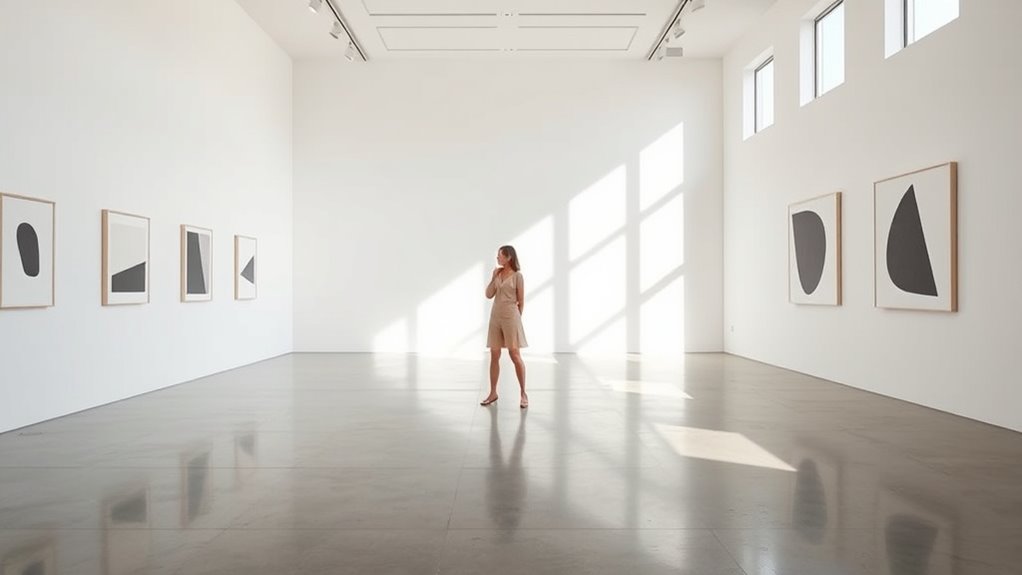Minimalist art movements are gaining traction due to their simple, clean lines and focus on essential elements, resonating with contemporary tastes. Modern digital platforms like Instagram and virtual galleries help showcase minimalist works worldwide, boosting their popularity. The movement’s influence extends into interior design and everyday life, emphasizing functionality and calmness. As trendy but timeless, minimalist art continues evolving with technology and social change—exploring new ways to inspire and engage audiences. If you keep exploring, you’ll discover more about this enthralling surge.
Key Takeaways
- Digital platforms like Instagram and TikTok are increasing visibility and popularity of minimalist art worldwide.
- Virtual galleries and online exhibitions make minimalist works more accessible and engaging to global audiences.
- Contemporary interior design trends emphasize simplicity and neutral palettes, boosting minimalist aesthetic adoption.
- AI and interactive digital tools enable innovative minimalist art creation and new audience participation.
- Minimalism’s focus on clarity and function aligns with societal shifts toward sustainability and mindful consumption.
The Origins and Evolution of Minimalist Art
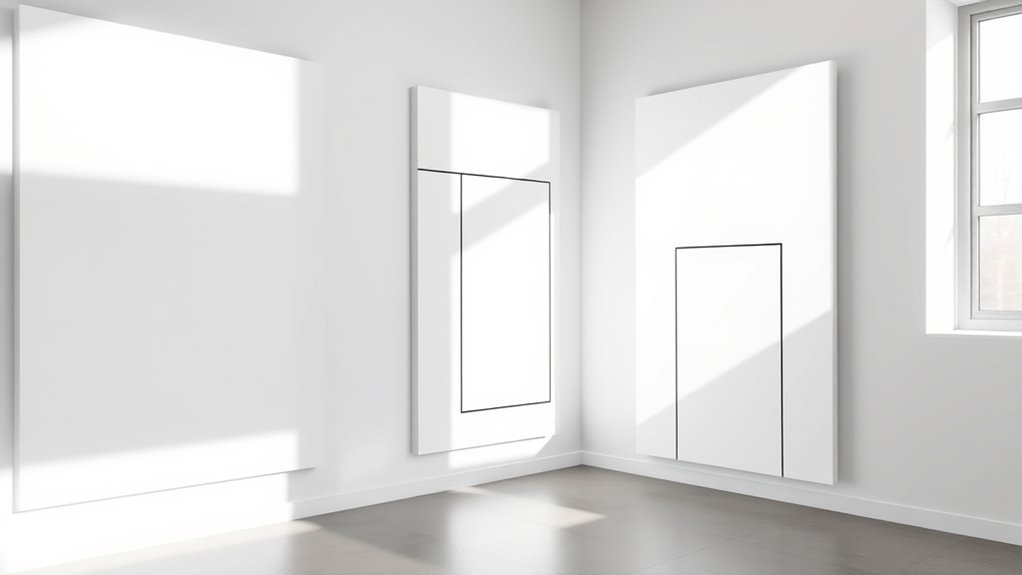
Minimalist art emerged in the 1950s and 1960s as a response to the emotional intensity and complexity of earlier modern art movements. Instead of conveying deep feelings through detailed imagery, minimalist artists focused on simplicity, using basic shapes and limited color palettes. Color theory played a pivotal role, as artists selected hues carefully to evoke specific feelings or create visual harmony. This approach minimized emotional expression, emphasizing form and material over personal sentiment. By stripping art down to its essentials, they aimed to engage viewers through pure visual experience rather than emotional storytelling. The evolution of minimalist art reflects a deliberate shift toward clarity and objectivity, encouraging you to focus on the artistic principles of the work without distraction. This movement transformed how you experience and interpret art, emphasizing visual clarity and the purity of form, which further highlights the importance of aesthetic simplicity in creating a cohesive artistic language. Additionally, the movement’s emphasis on conceptual purity has influenced various contemporary design and art practices, reinforcing the enduring significance of these core ideas.
Key Artists Shaping the Minimalist Movement
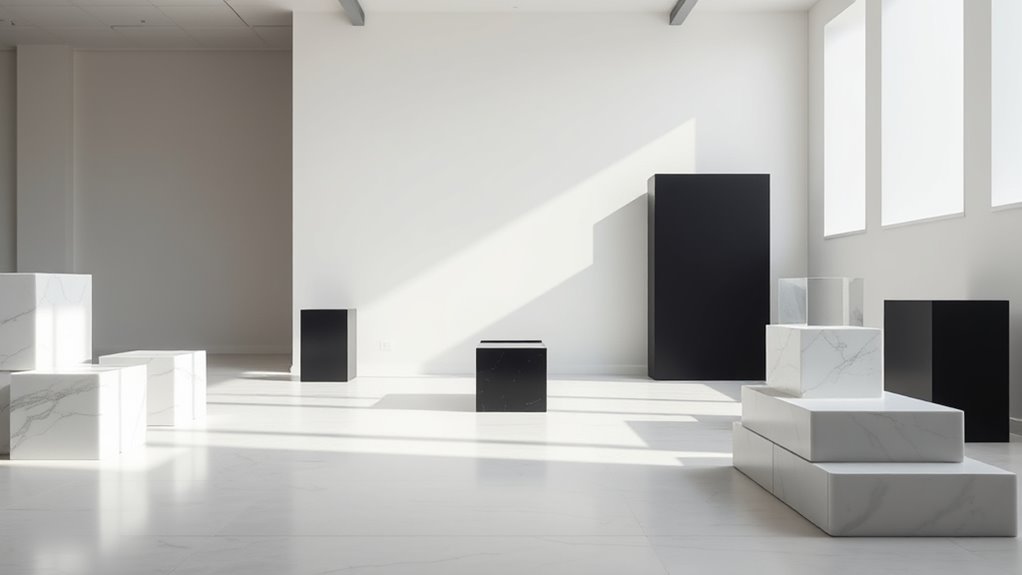
Several influential artists defined and advanced the minimalist movement through their innovative use of simple forms and materials. They focused on abstract forms and color blocking to create striking visual experiences. Additionally, the movement’s emphasis on visual simplicity has contributed to its growing popularity among contemporary artists and collectors. The use of essential oils in various applications reflects a similar appreciation for purity and straightforwardness that resonates with minimalist aesthetics. This shared value of aesthetic clarity underscores the movement’s appeal to those seeking purity in form and meaning. Moreover, minimalist art often employs precise geometric shapes, which align with the movement’s core principles of clarity and simplicity.
Techniques and Materials in Minimalist Creations
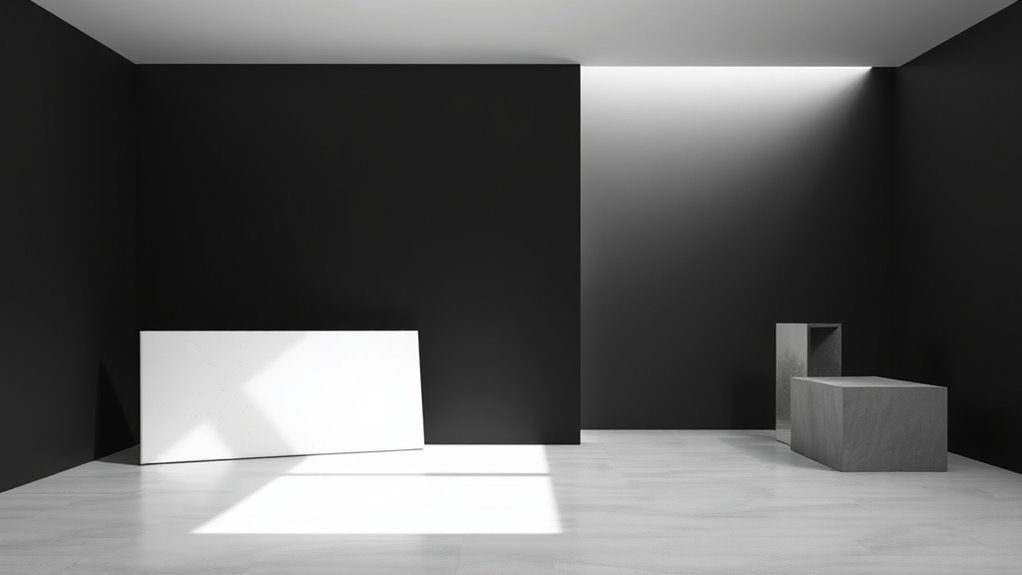
You notice that minimalist art often features simplified color palettes, using just a few carefully chosen hues. Artists also incorporate industrial materials like steel, concrete, and glass to achieve clean, unembellished surfaces. These techniques emphasize form and material, stripping away excess to highlight essential elements. Vibrational energy plays a crucial role in how these artworks evoke emotional responses and convey their minimalist essence. Additionally, understanding sound design principles can enhance the sensory experience of minimalist installations by integrating subtle audio elements that complement the visual simplicity. Recognizing the importance of figurative language techniques can also help artists evoke deeper emotional connections through visual metaphors and symbolism. Incorporating interior decor elements that align with minimalist principles can further reinforce the overall aesthetic and ambiance, especially considering how cybersecurity measures are vital in protecting digital art installations from cyber threats.
Simplified Color Palettes
Have you ever noticed how minimalist artworks often rely on just a few carefully chosen colors to convey their essence? Simplified color palettes are central to this approach, emphasizing color harmony to create balance and coherence. Proper color selection can significantly influence the viewer’s perception and emotional response to the piece. Using limited hues, artists focus on the emotional impact of each shade, evoking feelings with minimal complexity. Additionally, understanding color theory helps artists craft more compelling compositions that resonate on a subconscious level. They select colors that complement each other for visual unity. Monochromatic schemes emphasize subtle variations and depth. Bold, contrasting colors draw attention and create focal points. Neutral tones promote calmness and simplicity. Color choice often reflects the artwork’s mood or message, and awareness of emotional impact guides artists in creating evocative minimalistic pieces. Exploring regional trends in color usage can also influence contemporary minimalist art styles.
Use of Industrial Materials
Minimalist artists often choose industrial materials such as steel, concrete, glass, and aluminum to emphasize simplicity and functionality. These materials highlight industrial textures that add depth and character to their works without unnecessary ornamentation. Their use of materials underscores the importance of material durability, allowing creations to withstand time and environmental factors. By incorporating raw, unrefined surfaces, artists showcase the beauty of material honesty and structural integrity. The industrial aesthetic often involves exposing structural elements and celebrating imperfections, which enhances the authentic feel of minimalist designs. This approach shifts focus from decorative details to the intrinsic qualities of the materials themselves. You’ll notice how these choices create a sense of order and clarity, emphasizing the connection between form and function. The use of industrial materials aligns perfectly with minimalist principles, emphasizing simplicity while embracing the strength and permanence of industrial textures. Moreover, this material choice often reflects a conscious rejection of ornate or traditional materials, aligning with minimalist philosophy.
The Role of Digital Media in Promoting Minimalism

Digital media plays a vital role in spreading minimalist ideas to a global audience quickly and easily. Social media platforms allow artists to share their work directly with viewers, amplifying minimalist aesthetics.
Virtual galleries also create accessible spaces where you can experience minimalist art without leaving your home.
Social Media Amplification
Social media platforms have become powerful tools for spreading minimalist art, allowing artists and enthusiasts to reach wide audiences instantly. You can showcase your work, connect with others, and share ideas that blend minimalism with influences like pop art and surrealism.
The visual nature of platforms like Instagram and TikTok amplifies these movements by highlighting clean lines and bold concepts.
- Share behind-the-scenes glimpses of minimalist projects inspired by pop art or surrealism
- Use trending hashtags to reach new followers interested in modern art
- Collaborate with other artists to create minimalist-themed content
- Curate feeds that emphasize simplicity and visual clarity
- Participate in challenges promoting minimalist aesthetics and digital art styles
This digital engagement helps elevate minimalist movements, making them more accessible and influential worldwide.
Virtual Galleries Showcase
As artists and enthusiasts harness the power of online platforms to share their work, virtual galleries have become vibrant spaces for showcasing minimalist art. These digital exhibitions allow you to explore minimalist pieces without geographical limits, making art more accessible than ever.
In a virtual gallery, you can navigate through carefully curated collections, zoom into subtle details, and appreciate the simplicity of each work. Digital exhibitions highlight the clean lines, negative space, and understated elegance central to minimalism.
They also enable artists to reach a global audience instantly, broadening appreciation for this movement. As you explore these virtual galleries, you experience minimalist art in a fresh, immersive way, demonstrating how digital media amplifies its reach and impact.
Minimalism’s Influence on Contemporary Interior Design
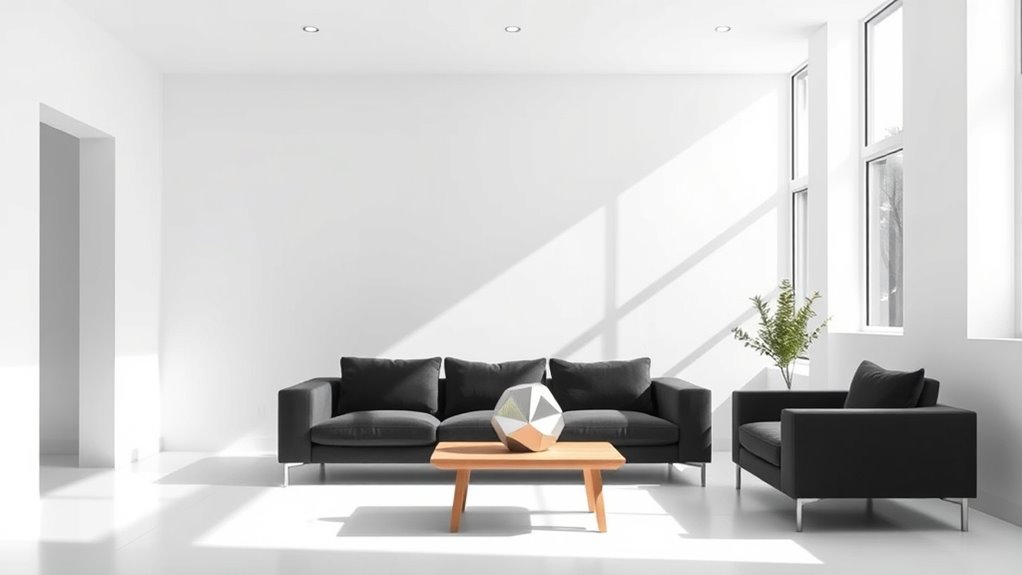
Minimalism has profoundly shaped contemporary interior design by emphasizing simplicity, clean lines, and functional spaces. You notice how spaces feel calm and uncluttered, thanks to principles like functional simplicity and aesthetic reduction.
Minimalism creates calm, uncluttered spaces through simplicity and functional design.
Designers focus on essentials, removing unnecessary ornamentation to create a sense of openness. This approach fosters a peaceful environment where every piece serves a purpose.
Key aspects include:
- Use of neutral color palettes to enhance serenity
- Streamlined furniture with sleek, geometric forms
- Open floor plans promoting spaciousness
- Hidden storage solutions for a clutter-free look
- Minimal decorative accents that emphasize quality over quantity
Cultural and Social Factors Driving Minimalist Trends
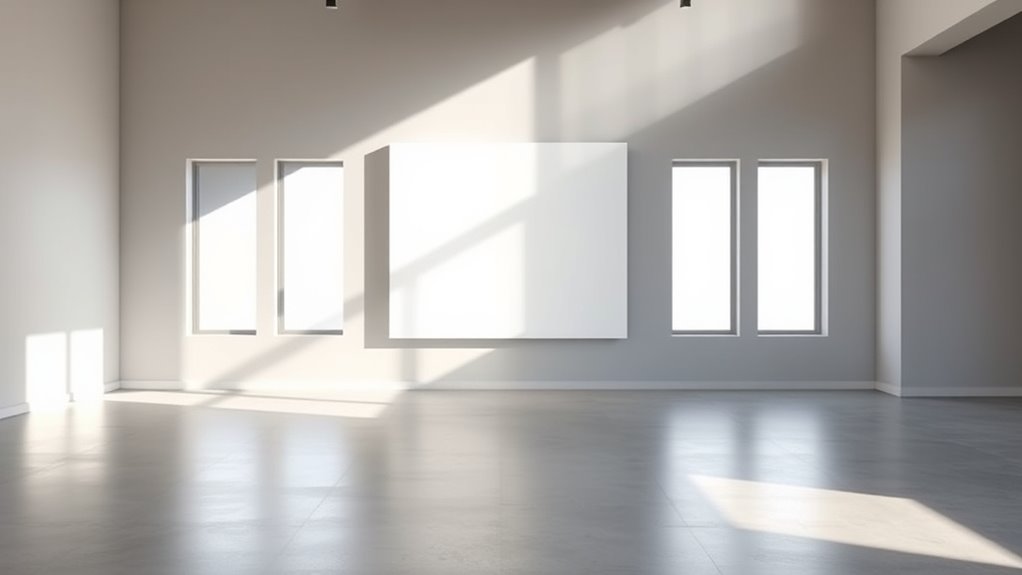
Changing cultural values and societal priorities have markedly fueled the rise of minimalist trends. Urban influence plays a significant role, as city living often emphasizes efficiency, simplicity, and functional design to cope with limited space and fast-paced lifestyles.
You notice this shift in how people prioritize quality over quantity, seeking meaningful experiences rather than material possessions. Economic factors also contribute, as economic uncertainty encourages frugal consumption and a desire for timeless, versatile items.
Minimalism offers an escape from excess and clutter, aligning with a collective move toward sustainability and mindful living. This cultural shift reflects a broader desire to declutter both physical spaces and mental states, making minimalist aesthetics a natural response to contemporary social and economic realities.
Comparing Minimalism With Other Modern Art Movements
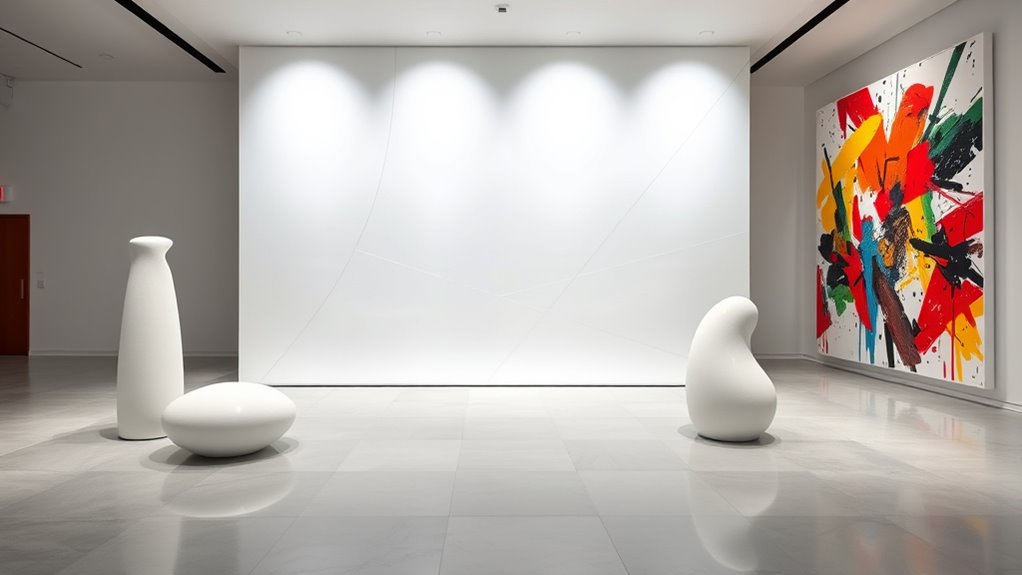
While minimalism emphasizes simplicity, clean lines, and functional design, it differs markedly from other modern art movements like Abstract Expressionism and Surrealism. You’ll notice that minimalist works often avoid complex color symbolism, favoring neutral palettes that evoke calm and clarity.
In contrast, Abstract Expressionism uses bold colors and vigorous brushstrokes to convey raw emotional expression. Surrealism, meanwhile, immerses you in dreamlike scenes filled with symbolic imagery.
Here’s how they compare:
- Minimalism strips art down to essentials, focusing on form and space.
- Abstract Expressionism relies on spontaneous brushwork to express emotion.
- Surrealism explores subconscious symbolism and surreal narratives.
- Minimalist color schemes tend to be subdued; others use vibrant hues for emotional impact.
- Minimalism seeks universal calm; other movements evoke personal emotional responses.
Challenges and Criticisms Faced by Minimalist Artists

Despite its emphasis on simplicity, minimalist artists often face criticism for their work being perceived as cold, sterile, or lacking emotional depth. Many struggle with maintaining artistic authenticity amidst commercialization challenges, as their minimalist style can be watered down for mass appeal. Critics argue that minimalism risks losing its core message when influenced by market trends. You might find it difficult to express complex ideas with minimal elements, risking superficiality. Here’s a quick look at common challenges:
| Challenge | Impact | Response |
|---|---|---|
| Artistic authenticity | Questions about genuine intent | Stay true to core principles |
| Commercialization | Dilutes original message | Balance art and market needs |
| Emotional depth | Perceived lack of feeling | Focus on subtle emotional cues |
| Public perception | Misunderstanding minimalism | Educate viewers on intent |
The Future of Minimalist Art in a Digital World
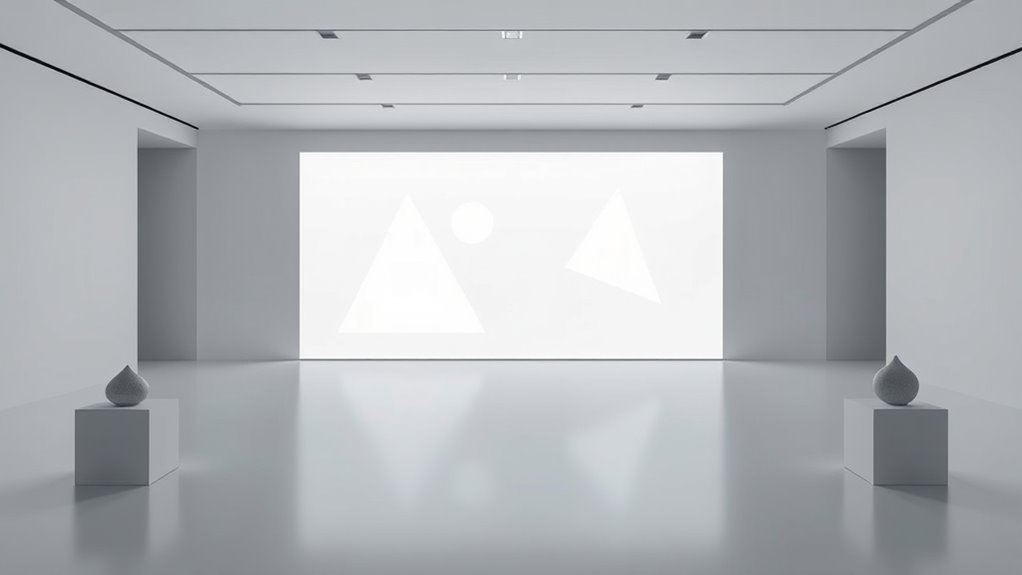
As digital technology continues to transform how we create and experience art, minimalist artists have new opportunities to innovate and reach wider audiences. You’ll see how color symbolism becomes more dynamic, allowing for deeper emotional expression through simple forms. Digital tools enable artists to experiment with subtle shifts in hue and tone, enhancing the impact of minimalism.
Interactive platforms and virtual galleries make it easier to share minimalist works globally, fostering diverse interpretations. You might also explore AI-generated art, pushing the boundaries of emotional expression within minimalist aesthetics.
- Virtual exhibitions expanding accessibility
- AI-assisted designs emphasizing color symbolism
- Interactive artworks engaging viewers emotionally
- New digital mediums for subtle minimalism
- Global collaborations amplifying minimalist ideas
Frequently Asked Questions
How Is Minimalism Influencing Global Art Markets Today?
You see minimal art’s impact in today’s global markets through its emphasis on simplicity and clean aesthetics. This movement influences artists and collectors worldwide, encouraging a focus on essential forms and materials.
Its global influence pushes prices higher at auctions and inspires new art forms across cultures. You might notice minimalist designs in contemporary galleries and public spaces, showing how this style continues to shape the international art scene.
What Psychological Effects Does Minimalist Art Have on Viewers?
You might find that minimalist art enhances your visual clarity, helping you focus and reduce mental clutter. Studies show 65% of viewers report feeling more emotionally calm when engaging with simple, clean designs.
This art style’s emphasis on basic shapes and muted colors fosters a sense of tranquility, allowing you to experience a peaceful, balanced state. It’s a powerful way to promote mental clarity and emotional well-being through visual simplicity.
Are There Any Notable Minimalist Movements Emerging Outside Western Countries?
You’ll find that non-western minimalist art is increasingly gaining recognition as part of emerging global movements. Countries like Japan, India, and China are developing their own minimalist styles that reflect their cultural identities.
These movements focus on simplicity and essence, resonating with global audiences. You might notice how these non-western minimalist works challenge traditional boundaries, offering fresh perspectives that enrich the worldwide appreciation of minimalist art.
How Do Minimalist Principles Translate Into Fashion and Design Industries?
You see that in fashion and design, minimalist principles emphasize functionality focus and aesthetic simplicity. You choose streamlined clothing with clean lines and neutral colors, appreciating how less clutter enhances usability.
In design, you notice spaces that feature simple forms and minimal decor, creating calm environments. By prioritizing essential elements and avoiding excess, you experience how minimalism fosters clarity, elegance, and practicality in everyday life.
What Challenges Do Young Artists Face When Pursuing Minimalism?
You face the challenge of balancing creative freedom with technical mastery, often feeling constrained by minimalist ideals. While simplicity invites clarity, it demands precision, making it hard to stand out without sacrificing authenticity.
You might struggle to communicate complex ideas through limited elements, risking oversimplification. Yet, these obstacles push you to refine your skills and find innovative ways to express yourself, transforming restrictions into opportunities for deeper artistic exploration.
Conclusion
As you explore minimalist art, you’ll find it gently invites reflection amidst simplicity, subtly challenging you to see beyond the surface. Its understated elegance offers a quiet space for thought, even as it quietly evolves within a fast-paced world. Embracing minimalism‘s understated charm allows you to appreciate how less can indeed be more, guiding you toward a deeper understanding of beauty and meaning that lingers in the subtle.
